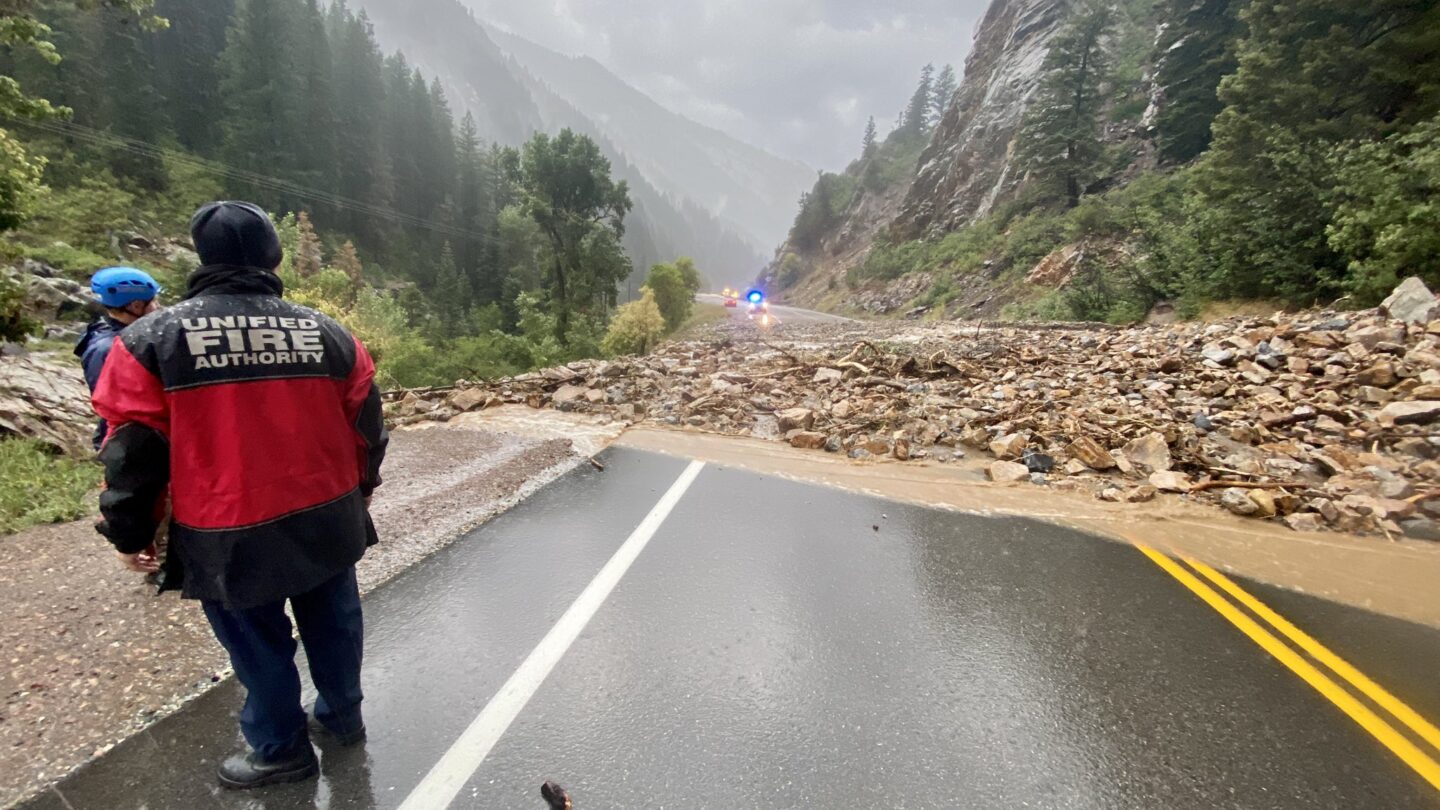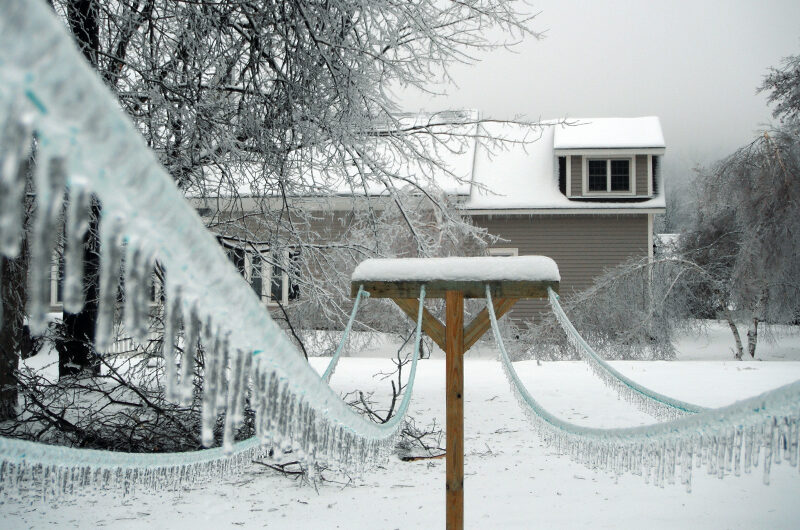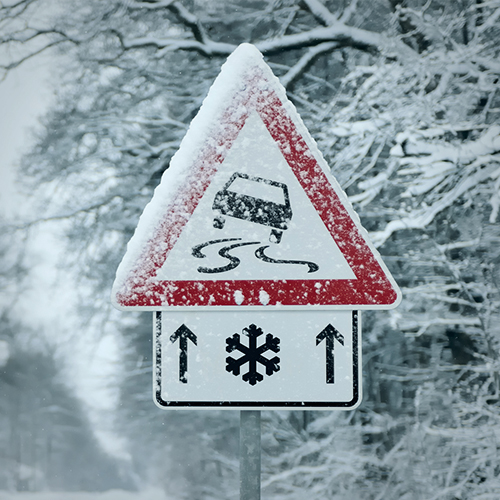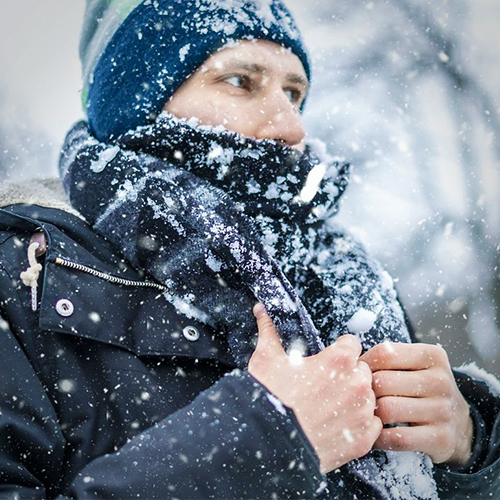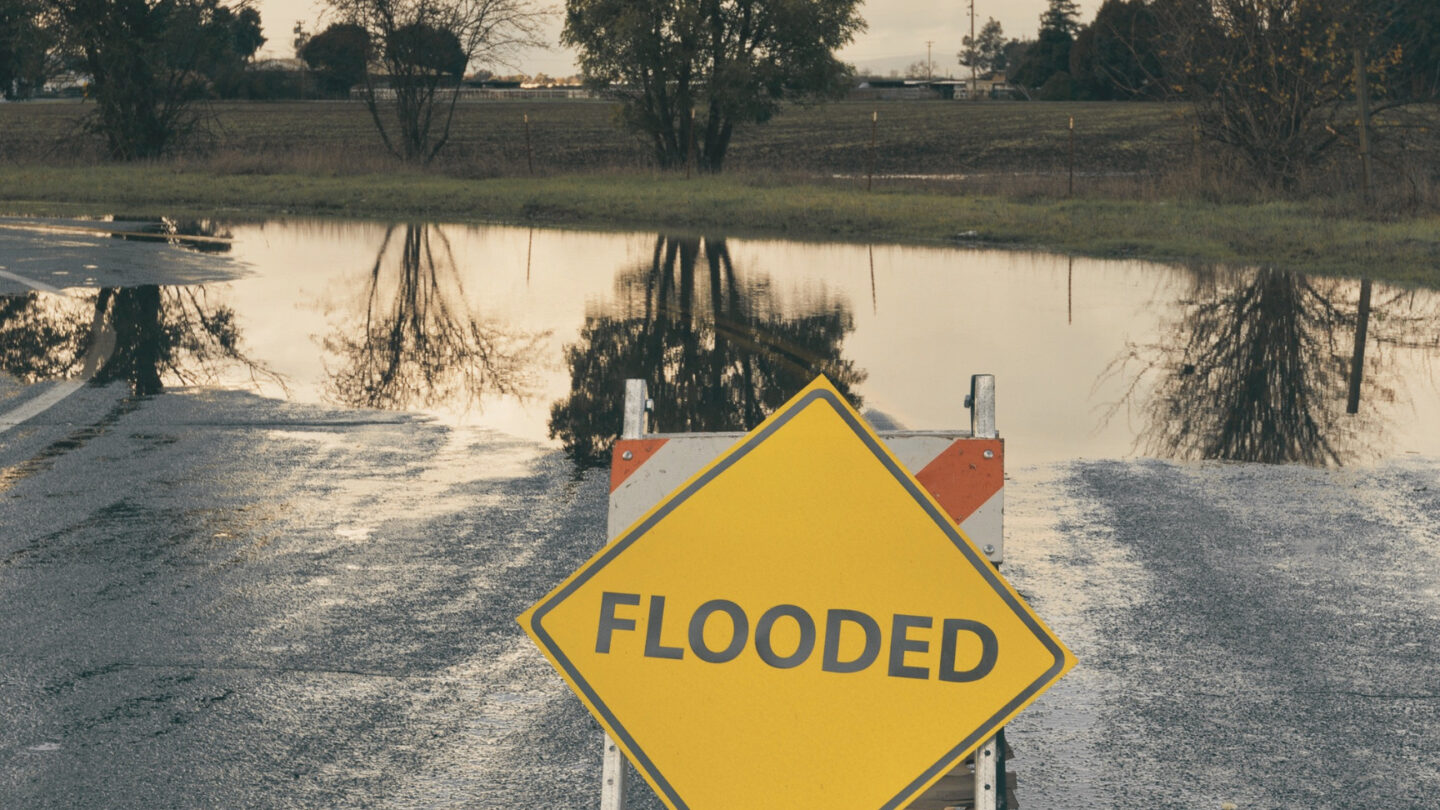
Avalanches
HOW TO PROTECT YOURSELF FROM AN AVALANCHE
 THE MOST IMPORTANT ACTIONS YOU CAN TAKE TO SURVIVE AN AVALANCHE ARE DONE BEFORE IT HAPPENS.
THE MOST IMPORTANT ACTIONS YOU CAN TAKE TO SURVIVE AN AVALANCHE ARE DONE BEFORE IT HAPPENS.
An avalanche is a large amount of snow moving quickly down a mountain, typically on slopes of 30 to 45 degrees. When an avalanche stops, the snow becomes solid like concrete and people are unable to dig out. People caught in avalanches can die from suffocation, trauma, or hypothermia.
AVALANCHES CAN:
- Be caused by people, new snow and wind.
- Move at speeds of 60 to 80 MPH.
- Peak during the period of December through March.
KNOW YOUR AVALANCHE RISK
Learn about your local avalanche risk. Know the signs of increased danger, including recent avalanches and shooting cracks across slopes. Avoid areas of increased risk, such as slopes steeper than 30 degrees or areas under steep slopes. Get training on how to recognize hazardous conditions and avalanche-prone locations. Sign up for alerts from a U.S. Forest Service Avalanche Center near you. Your community may also have a local warning system.
PREPARING FOR AVALANCHE
Get proper equipment to protect yourself from head injuries and create air pockets. Receive first aid training so you can recognize and treat suffocation, hypothermia, traumatic injury and shock. Wear a helmet to help reduce head injuries and create air pockets. Wear an avalanche beacon to help rescuers locate you. Use an avalanche airbag that may help you from being completely buried. Carry a collapsible avalanche probe and a small shovel to help rescue others.
CONSIDER OVERLAPPING HAZARDS: CORONAVIRUS DISEASE 2019 (COVID-19)
Remember, there is no evidence that cold weather and snow can kill the coronavirus disease. Be sure to have several clean masks to use in case your mask becomes wet or damp from snow. Cloth masks should not be worn when they become damp or wet. Be sure to wash your mask regularly.
Masks may make it difficult to breathe, especially for those engaging in high intensity activities. Remove your mask if you are having difficulty breathing. If you are unable to wear a mask, maintain a distance of at least six feet between yourself and others.
SIGNS OF AVALANCHE
Learn the signs of an avalanche, and how to use safety and rescue equipment.
Follow avalanche warnings on roads. Roads may be closed, or vehicles may be advised not to stop on the roadside.
STAY SAFE DURING AN AVALANCHE
- Use and carry safety equipment and rescue gear.
- If your partner or others are buried, call 9-1-1 and then begin to search if it is safe to do so.
- If you have the proper training, treat others for suffocation, hypothermia, traumatic injury or shock.

RETURNING AFTER AN AVALANCHE
Know the signs and ways to treat hypothermia.
- Hypothermia is an unusually low body temperature. A body temperature below 95 degrees is an emergency.
- Signs: Shivering, exhaustion, confusion, fumbling hands, memory loss, slurred speech and drowsiness.
- Actions: Go to a warm room or shelter. Warm the center of the body first—chest, neck, head and groin. Keep the person dry and wrapped up in warm blankets, including the head and neck.
- Engage virtually with your community through video and phone calls. Know that it’s normal to feel anxious or stressed. Take care of your body and talk to someone if you are feeling upset.
Salt Lake County Hazard Mitigation Plan
Hazard mitigation planning involves states, territories, local governments, tribes, and special districts to develop a strategic vision for reducing disaster risk.
Local plans are the foundation of a community’s long-term strategy to reduce disaster losses and break the cycle of disaster damage, reconstruction, and repetitive damage.

Salt Lake County Hazard Mitigation Plan
(Coming Soon)
What is the purpose of hazard mitigation planning? The purpose is to identify what hazards could potentially impact our area and what the potential impacts of those hazards are, as well as develop goals to reduce or eliminate the long-term risk to life and property from those hazards. Communities in Salt Lake County are collaborating to complete this plan together.
Why is mitigation important? In addition to protecting life and property, taking action to reduce risks is a good investment. The plan helps focus resources on areas at greatest risk.
What are some examples of mitigation actions?
- Retrofitting or fortifying existing structures and critical facilities to increase their ability to withstand disasters.
- Remove or relocate structures from high-risk areas to minimize future loss.
- Adopt building codes and development standards to ensure structures are better able to withstand disaster.
- Create educational or outreach programs to advise citizens of risks.
What is the timeline for this mitigation plan? These plans are updated every 5 years to identify any changes in risk or priorities. Salt Lake County has previously completed mitigation plans in 2019, 2014, and 2009.
Who does the hazard mitigation plan impact? Having a hazard mitigation plan can benefit the whole county. It will increase our awareness of hazards and vulnerabilities. Taking action will make the community more resilient to those hazards.
Participating Partners
- Salt Lake County
- Alta
- Brighton
- Bluffdale
- Copperton
- Cottonwood Heights
- Draper
- Emigration Canyon
- Herriman City
- Holladay
- Kearns
- Magna
- Midvale
- Millcreek
- Murray
- Riverton
- Salt Lake City
- Salt Lake County
- Sandy
- South Jordan
- South Salt Lake
- Taylorsville
- West Jordan
- White City
- West Valley
- Salt Lake Community College
- Canyons School District
- Jordan School District
- UTA
Winter Weather
HOW TO PROTECT YOURSELF FROM WINTER WEATHER
 IF YOU ARE UNDER A WINTER STORM WARNING, FIND SHELTER RIGHT AWAY
IF YOU ARE UNDER A WINTER STORM WARNING, FIND SHELTER RIGHT AWAY
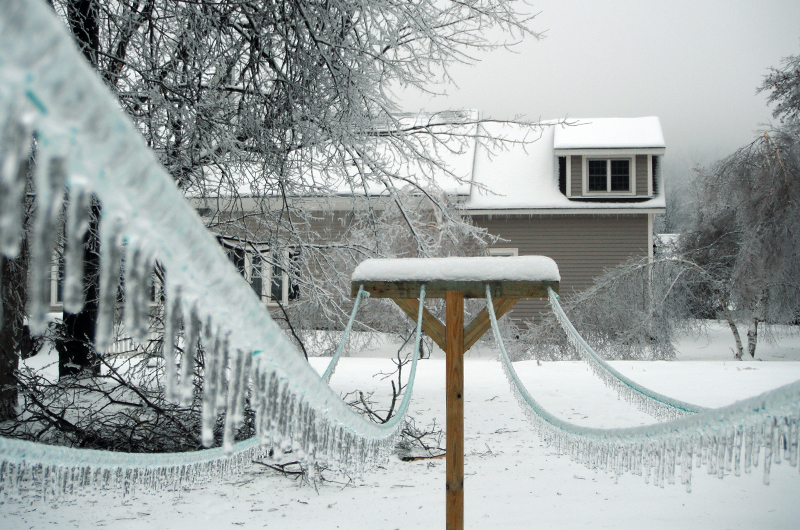
Winter storms create a higher risk of car accidents, hypothermia, frostbite, carbon monoxide poisoning, and heart attacks from overexertion. Winter storms including blizzards can bring extreme cold, freezing rain, snow, ice and high winds.
A WINTER STORM CAN:
- Last a few hours or several days.
- Cut off heat, power and communication services.
- Put older adults, children, sick individuals and pets at greater risk.
KNOW YOUR WINTER WEATHER TERMS:
Winter Storm Warning
Issued when hazardous winter weather in the form of heavy snow, heavy freezing rain, or heavy sleet is imminent or occurring. Winter Storm Warnings are usually issued 12 to 24 hours before the event is expected to begin.
Winter Storm Watch
Alerts the public to the possibility of a blizzard, heavy snow, heavy freezing rain, or heavy sleet. Winter Storm Watches are usually issued 12 to 48 hours before the beginning of a Winter Storm.
Winter Weather Advisory
Issued for accumulations of snow, freezing rain, freezing drizzle, and sleet which will cause significant inconveniences and, if caution is not exercised, could lead to life-threatening situations.
KNOW YOUR RISK FOR WINTER STORMS
Pay attention to weather reports and warnings of freezing weather and winter storms. Listen for emergency information and alerts. Sign up for your community’s warning system. The Emergency Alert System (EAS) and National Oceanic and Atmospheric Administration (NOAA) Weather Radio also provide emergency alerts.
PREPARING FOR WINTER WEATHER
Prepare your home to keep out the cold with insulation, caulking and weather stripping. Learn how to keep pipes from freezing. Install and test smoke alarms and carbon monoxide detectors with battery backups. Gather supplies in case you need to stay home for several days without power. Keep in mind each person’s specific needs, including medication. Remember the needs of your pets. Have extra batteries for radios and flashlights. If you are unable to afford your heating costs, weatherization or energy-related home repairs, contact the Low Income Home Energy Assistance Program (LIHEAP) for help.
IN CASE OF EMERGENCY
Be prepared for winter weather at home, at work and in your car. Create an emergency supply kit for your car. Include jumper cables, sand, a flashlight, warm clothes, blankets, bottled water and non-perishable snacks. Keep a full tank of gas.
CORONAVIRUS DISEASE 2019 (COVID-19)
Sign up for email updates about coronavirus from the Centers for Disease Control and Prevention (CDC). Learn the symptoms of COVID-19 and follow CDC guidance. If you are able to, set aside items like soap, hand sanitizer that contains at least 60 percent alcohol, disinfecting wipes, and general household cleaning supplies that you can use to disinfect surfaces you touch regularly.
August 3-4 Severe Thunderstorms & Flooding
U.S. SMALL BUSINESS ADMINISTRATION DISASTER LOANS
Incident: SEVERE THUNDERSTORMS & FLOODING
occurring: August 3 through August 4, 2023
Click here for the SBA Fact Sheet in English
Click Here for the SBA Fact Sheet in Spanish
| Release Date: Oct. 2, 2023 | Media Contact: Mark W. Randle, (916) 735‑1500, [email protected] |
| Release Number: UT 20006-01 | Follow us on Twitter/X, Facebook, Blogs & Instagram |
SBA Offers Disaster Assistance to Utah Businesses and Residents Affected by Severe Thunderstorms and Flooding
SACRAMENTO, Calif. – Low-interest federal disaster loans are available to Utah businesses and residents affected by severe thunderstorms and flooding that occurred Aug. 3 – 4, announced Administrator Isabella Casillas Guzman of the U.S. Small Business Administration. SBA acted under its own authority to declare a disaster in response to a request SBA received from Gov. Spencer Cox, on Sept. 28.
The disaster declaration makes SBA assistance available in Davis, Morgan, Salt Lake, Summit, Tooele, Utah and Wasatch counties.
“SBA’s mission-driven team stands ready to help Utah’s small businesses and residents impacted by severe thunderstorms and flooding,” said Administrator Guzman. “We’re committed to providing federal disaster loans swiftly and efficiently, with a customer-centric approach to help businesses and communities recover and rebuild.”
“Low-interest federal disaster loans are available to businesses of all sizes, most private nonprofit organizations, homeowners and renters whose property was damaged or destroyed by this disaster,” said Director Jeffrey Lusk of the U.S. Small Business Administration’s Disaster Field Operations Center-West. “Beginning Tuesday, Oct. 3, SBA customer service representatives will be on hand at the following Disaster Loan Outreach Center to answer questions about SBA’s disaster loan program, explain the application process and help each individual complete their application,” Lusk continued. The center will be open on the days and times indicated below until further notice. No appointment is necessary.
SALT LAKE COUNTY
Disaster Loan Outreach Center
The Fitzgerald House
1160 E. Pioneer Rd.
Draper, UT 84020
Opens at 9 a.m. Tuesday, Oct. 3
Mondays – Fridays, 9 a.m. – 6 p.m.
Closed Monday, Oct. 9 in observance of Columbus Day
Businesses of all sizes and private nonprofit organizations may borrow up to $2 million to repair or replace damaged or destroyed real estate, machinery and equipment, inventory and other business assets. SBA can also lend additional funds to help with the cost of improvements to protect, prevent or minimize disaster damage from occurring in the future.
For small businesses, small agricultural cooperatives, small businesses engaged in aquaculture and most private nonprofit organizations of any size, SBA offers Economic Injury Disaster Loans to help meet working capital needs caused by the disaster. Economic injury assistance is available regardless of whether the business suffered any property damage.
Disaster loans up to $500,000 are available to homeowners to repair or replace damaged or destroyed real estate. Homeowners and renters are eligible for up to $100,000 to repair or replace damaged or destroyed personal property, including personal vehicles.
Interest rates can be as low as 4 percent for businesses, 2.375 percent for private nonprofit organizations and 2.5 percent for homeowners and renters with terms up to 30 years. Loan amounts and terms are set by SBA and are based on each applicant’s financial condition.
Interest does not begin to accrue until 12 months from the date of the first disaster loan disbursement. SBA disaster loan repayment begins 12 months from the date of the first disbursement.
Applicants may apply online, receive additional disaster assistance information and download applications at https://disasterloanassistance.sba.gov/. Applicants may also call SBA’s Customer Service Center at (800) 659-2955 or email [email protected] for more information on SBA disaster assistance. For people who are deaf, hard of hearing, or have a speech disability, please dial 7-1-1 to access telecommunications relay services. Completed applications should be mailed to U.S. Small Business Administration, Processing and Disbursement Center, 14925 Kingsport Road, Fort Worth, TX 76155.
The deadline to apply for property damage is Dec. 1, 2023.
The deadline to apply for economic injury is July 2, 2024.
About the U.S. Small Business Administration
The U.S. Small Business Administration helps power the American dream of business ownership. As the only go-to resource and voice for small businesses backed by the strength of the federal government, the SBA empowers entrepreneurs and small business owners with the resources and support they need to start, grow, expand their businesses, or recover from a declared disaster. It delivers services through an extensive network of SBA field offices and partnerships with public and private organizations. To learn more, visit www.sba.gov.
COMUNICADO DE PRENSA
Disaster Field Operations Center West
| Fecha: 2 de octubre de 2023 | Contacto para la Prensa: Mark W. Randle, (916) 735 1500, [email protected] |
| Número: UT 20006-01 | Síguenos en Twitter/X, Facebook, Blogs & Instagram |
La SBA Ofrece Asistencia de Desastres a los Negocios y Residentes del Estado de Utah afectados por las Severas Tormentas Eléctricas e Inundaciones
SACRAMENTO, Calif. – Préstamos federales para desastres a bajos intereses están disponibles para los negocios y residentes del estado de Utah que se vieron afectados por las severas tormentas eléctricas e inundaciones que ocurrieron del 3 al 4 de agosto, anunció la Administradora Isabella Casillas Guzman de la Agencia Federal de Pequeños Negocios (SBA, por sus siglas en inglés). La SBA decidió bajo su propia autoridad declarar un desastre en respuesta a la solicitud del Gobernador Spencer Cox recibida por la SBA el 28 de septiembre.
La declaración de desastre pone la asistencia de la SBA disponible en los condados de Davis, Morgan, Salt Lake, Summit, Tooele, Utah y Wasatch.
“El equipo impulsado por la misión de la SBA está listo para ayudar a los negocios pequeños y residentes de Utah impactados por las severas tormentas eléctricas e inundaciones,” dijo la Administradora Guzman. “Estamos comprometidos a proporcionar préstamos para desastres federales lo más rápido y eficientemente, con un enfoque centrado en el cliente para ayudar a los negocios y las comunidades recuperarse y reconstruir.”
“Préstamos federales para desastres a bajos intereses están disponibles para negocios de cualquier tamaño, la mayoría de las organizaciones privadas sin fines de lucro, propietarios de vivienda e inquilinos que sufrieron daños o destrucción en su propiedad por el desastre,” dijo Jeffrey Lusk, Director del Centro de Desastres del Oeste (Disaster Field Operations Center-West) de la Agencia Federal de Pequeños Negocios (SBA, por sus siglas en inglés). “A partir del martes, 3 de octubre, representantes de la SBA estarán disponibles en el siguiente Centro de Promoción y Asistencia para Préstamos de Desastre (DLOC, por sus siglas en inglés) para responder a sus preguntas sobre el programa de préstamos para desastres, explicarles el proceso de la solicitud y ayudar a cada persona a completar su solicitud,” agregó Lusk. El centro estará abierto los días y horarios indicados a continuación. No es necesario hacer una cita.
CONDADO DE SALT LAKE Centro de Promoción y Asistencia para Préstamos de Desastres The Fitzgerald House 1160 East Pioneer Road Draper, UT 84020 Abrirá el martes, 3 de octubre, a las 9 a.m. Lunes – viernes, 9 a.m. – 6 p.m. Cerrado el lunes, 9 de octubre, para el Día de la Raza |
Negocios de cualquier tamaño y organizaciones privadas sin fines de lucro pueden obtener préstamos hasta $2 millones de dólares para reparar o reemplazar bienes inmuebles, maquinarias y equipos, inventarios y otros activos.La SBA también puede prestar fondos adicionales para ayudar con el costo de las mejoras destinadas a proteger, prevenir o minimizar daños por desastres que ocurran en el futuro.
Para los pequeños negocios, las pequeñas cooperativas agrícolas, los pequeños negocios involucrados en acuacultura, y para la mayoría de las organizaciones privadas sin fines de lucro de todos los tamaños, la SBA ofrece Préstamos de Desastre por Daños Económicos (EIDL, por sus siglas en inglés) para ayudar a cubrir las necesidades de capital circulante causadas por el desastre. La asistencia por daños económicos está disponible independientemente de si el negocio ha sufrido algún daño físico en la propiedad.
Los préstamos para desastres disponibles para propietarios de viviendas pueden ser hasta de $500,000 para reparar o reemplazar su residencia principal. Propietarios de viviendas e inquilinos pueden solicitar hasta $100,000 para reparar o reemplazar su propiedad personal dañada o destruida, incluyendo vehículos personales.
Las tasas de interés de los préstamos pueden ser tan bajas como 4 por ciento para negocios, 2.375 por ciento para organizaciones privadas sin fines de lucro y 2.5 por ciento para propietarios de vivienda e inquilinos por plazos de hasta 30 años. Los montos y términos de los préstamos los establece la SBA y se basan en las condiciones financieras de cada solicitante.
Los intereses no comienzan a acumularse hasta 12 meses después de la fecha del desembolso inicial del préstamo para desastres. El pago del préstamo por desastre de la SBA comienza 12 meses después de la fecha del primer desembolso.
Los interesados pueden llenar una solicitud en línea, recibir información adicional sobre asistencia de desastres y descargar la solicitud de préstamo en https://disasterloanassistance.sba.gov/. También pueden comunicarse al Centro de Servicio a Clientes para Asistencia de Desastres de la SBA marcando (800) 659‑2955 o enviando un correo electrónico a [email protected] para obtener mayor información. Para las personas con discapacidades auditivas o del habla, favor de marcar 7-1-1 para tener acceso al servicio de retransmisión de telecomunicaciones. Las solicitudes completadas en papel deben enviarse por correo a U.S. Small Business Administration, Processing and Disbursement Center, 14925 Kingsport Road, Fort Worth, TX 76155.
La fecha límite para solicitar un préstamo por daños físicos es el 1 de diciembre de 2023. La fecha límite para solicitar un préstamo por daños económicos es el 2 de julio de 2024.
Acerca de la Agencia Federal de Pequeños Negocios
La Agencia Federal de Pequeños Negocios hace realidad el sueño americano de ser propietario de un negocio. Como único recurso y voz para las pequeñas empresas y con el respaldo de la fortaleza del gobierno federal, la SBA permite a los empresarios y propietarios de pequeños negocios contar con los recursos y el apoyo que necesitan para crear, desarrollar o ampliar sus negocios o recuperarse de un desastre declarado. Ofrece servicios a través de su amplia red de oficinas de campo y asociaciones con organizaciones públicas y privadas. Para obtener más información, visite www.sba.gov o www.sba.gov/espanol.

